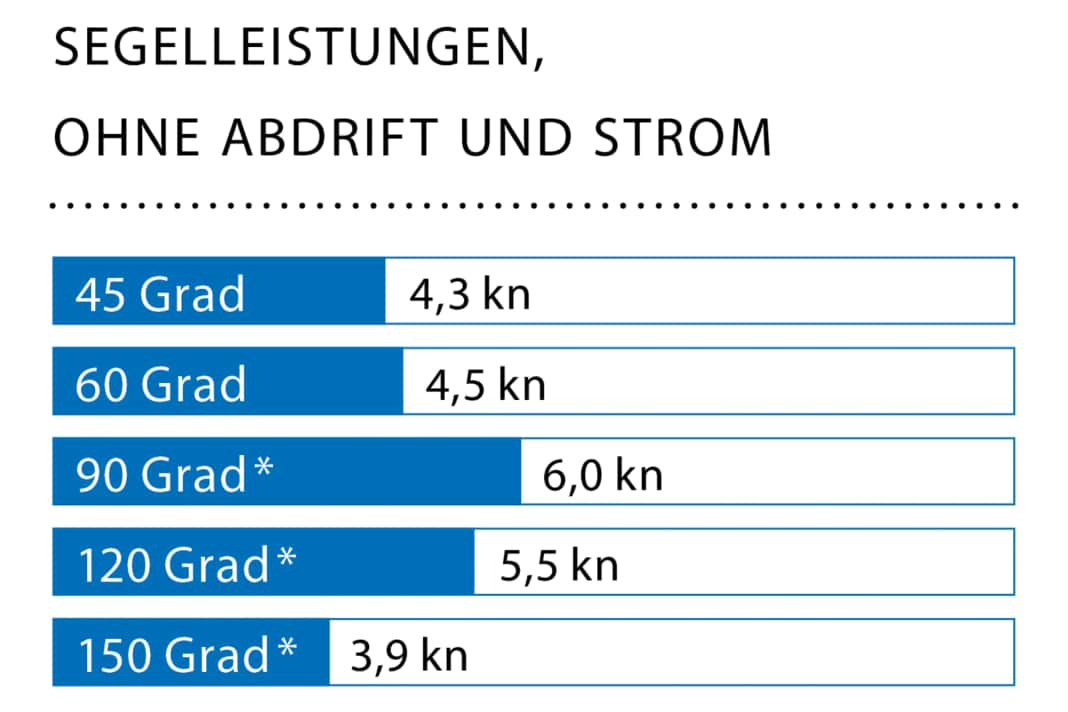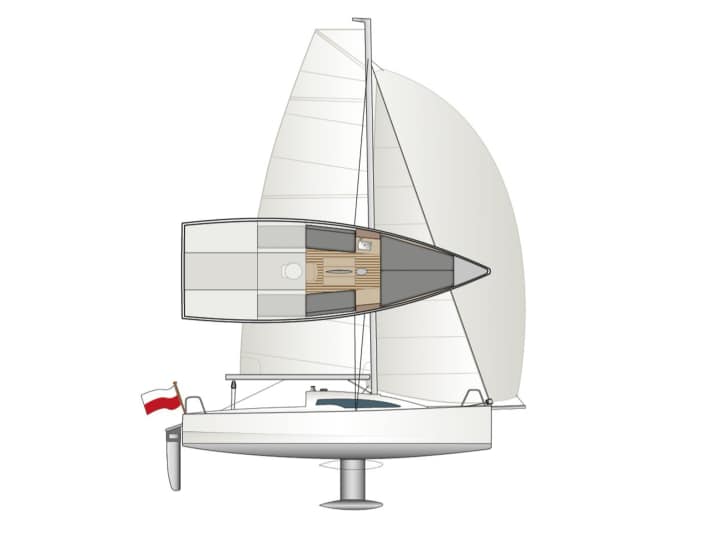





Years ago, the market was virtually flooded with small cruisers. The majority of these small all-rounders were produced in Poland and often had an unmistakably uniform design: between six and a half and eight metres long, voluminous for maximum living space below deck and with a variety of variable hull attachments. And what's more: extremely affordable.
Also interesting:
The number of new launches of this type has decreased recently, possibly due to a certain saturation of the market. However, small cruisers are still available in great abundance and variety, and they continue to enjoy stable demand. Nevertheless, one thing cannot be denied: Due to their usually aggressive pricing, they all too often have the image of being a supposedly cheap product - in many cases quite wrongly. Furthermore, small cruisers are generally not known for their high performance or proven sporty sailing characteristics.
A little bit of everything
Mariusz Sobusiak, a yacht builder from Poland, disproves the tiresome preconception with the Focus 750 Performance. His shipyard Yacht Yard is located in Lodz, pretty much in the centre of the country. The enterprising entrepreneur and his six or so employees have been building small sailing boats under the Focus brand name for many years. There is currently an 800 and a 730, both of which are aimed at cruising and family sailors. With the new boat, Sobusiak is now also targeting ambitious sportsmen and women who don't want to be left behind even in a busy regatta. However, the Poles have not lost sight of the issue of touring suitability. The Focus 750 is - if you like - a real performance cruiser in a small format.
This is also emphasised by the crack and the hull shape. The relatively slim boat in comparison, designed by Jerzy Piesniewsky, has pronounced chine edges that extend far forwards. The freeboard is less high than is usual for small cruisers, and the cabin superstructure is shorter so that there is more space in the cockpit for a sporty and active crew. The cockpit remains open aft and the rudder blade is attached to the stern, not underneath.
The customer also has the choice of ordering the boat with a long, extendable bowsprit for a gennaker or with a shorter, fixed bow nose for operation with Code Zero.
A lot of performance potential, which is also matched by the rig, at least in terms of mast height and sail area. With a value of 5.1, the sail carrying capacity is in a decidedly sporty range, closer to that of a regatta boat than a conventional small cruiser. However, this also means that the boat is sailed with more pressure. However, the simple, thin and rather soft single spreader mast of the Focus 750 does not seem to be built for this.
Potential still exists
In the test on Lake Neuchâtel in Switzerland, even in very light winds of only six knots, the powerful sail plan quickly requires more rig tension - but the clearly too thin shrouds and the toy-sized tensioners do not allow this. The shipyard is making savings in the wrong place here, especially as the rig concept does not provide for a backstay due to the large mainsail boom in the top area. As a result, the rig cannot be trimmed properly and the forestay sags in the wind, which is detrimental to the height.
Nevertheless, the Focus 750 still manages a tacking angle of 90 degrees and sails at a speed of a good 4.3 knots over the ground in just 2 Beaufort. With a properly equipped and stiffer rig, these already quite decent values could undoubtedly be increased.
Measured values of the Focus 750




Furthermore, the test boat for use in a Swiss sailing school is only equipped with the simple and inexpensive Dacron cloths supplied as standard; Sobusiak offers higher quality and more stable aramid foil sails as an extra. The approximately 50 square metre gennaker is available as an individual option or as part of the sports package together with the better sails, the extendable bowsprit and Ronstan fittings. Although the price for the performance-enhancing equipment bundle costs an extra charge, it is definitely a worthwhile investment.
The relatively long, but also flat rudder blade provides just enough pressure for the helmsman at the tiller to develop a good feel for the boat and steer it optimally. However, with the large gennaker and the long bowsprit (1.55 metres), there is also a pronounced tendency to lean on the pointed course, which is unpleasant and unusual. The helmsman has to counter-steer constantly, even when he is hoisting the mainsail tightly at the same time.
Mechanically first class
In the standard version, the Focus 750 Performance comes with a fully retractable ballast centreboard (300 kilograms). As an option - as with the test boat - the keel is functionally upgraded with a 50-kilogram lead bomb. In both cases, a lead granulate is moulded into the flat bilge as additional internal ballast (plus 200 kilograms) for more righting moment. The small Polin is therefore categorised as category B (with railing) or C (without railing) according to CE. Incidentally, the supports for the sea fence are anchored unusually solidly in the deck, as are the bow and stern pulpit.
The shipyard gets top marks for the design of the lifting keel and its mechanics. The fin is made entirely of stainless steel, with a solid frame inside, over which preformed metal sheets are welded into the profile without tension. The keel can be raised electrically and at the touch of a button via a very well-functioning mechanism, with a total stroke of 1.15 metres. The profile is optimally guided in the keel box so that it is possible to raise the trailer even a little in shallow waters. This worked perfectly in the YACHT test, even under sail and even when heeled.
As an alternative, the Focus 750 can be fitted with a fixed keel and lead bomb on request; the draughts remain the same. The boat is built from A to Z in the Yacht Yard shipyard. The hull and deck are built as GRP constructions with an Airex foam core using the complex but weight-saving vacuum infusion process.
With a lifting keel and retractable rudder, the Focus 750 can be easily launched and retrieved via the ramp. With a ship's width of 2.50 metres and a total weight ready to sail of just 1.3 tonnes, transport on the trailer is also no problem. And the shipyard offers a stable jibing device as an option for quickly raising and lowering the mast by hand.
Clean, but weak
Anyone who goes below deck will be amazed. Despite the relatively short cabin superstructure, the rather slim lines and the moderate freeboard height, the interior of the Focus 750 surprises with its extremely generous dimensions. In contrast to its sister models, the Focus 800 and 730, the new boat has neither a separate toilet room nor a permanently installed galley. The completely open interior naturally contributes greatly to the impression of spaciousness.
The test boat is also fitted with light-coloured oak. This is also an option; mahogany is used as standard. The workmanship is neat, even in the details, and Yacht Yard obviously works cleanly. In addition, inner shells provide beautiful surfaces. However, the Polish shipyard also seems to attach great importance to saving weight in the interior fittings: Some of the fittings are thin-walled and therefore appear less robust. Under the seating areas in the saloon, for example, the plywood lids of the storage compartments are so weak that they threaten to break through under load. The shipyard should make improvements here.
Four people can spend the night on the Focus 750 - and quite comfortably; the berths are large enough for this. Additional modules between the foredeck and saloon can be ordered as an extra, where a sink or washbasin and cooking facilities can be installed. And a chemical toilet can be placed in a pull-out drawer under the companionway - a very elegant solution, even if only for emergencies.
There is ample storage space everywhere under the berths and under the seats, as well as open storage spaces on the side of the hull. Ventilation options are limited, however, with only one hatch available below deck in the foredeck. Even with the companionway open, this is not sufficient for adequate ventilation.
Prices of the Focus 750
The Yacht Yard shipyard advertises its new Focus 750 with a comparatively favourable basic price of 46,700 euros incl. 19% VAT.
- Base price ex shipyard: 46,700 Euro incl. 19% VAT.
- Guarantee/against osmosis: 2/3 years
As of 2025, as the prices shown are defined, you will find here!
However, prospective buyers must realise that they will initially only receive the modestly configured basic version for the money. Until the boat is ready to sail (according to the YACHT definition), several thousand euros more will be due.
Conclusion
This may dampen the appeal of the Focus 750 Performance as an extremely versatile, versatile sports and touring boat that also cuts a fine figure under sail.
YACHT review of the Focus 750
The successful combination of sports boat and small cruiser from Poland impresses with its extremely versatile and versatile concept. The hull and deck are robustly built.
Design and concept
Versatile orientation
Different keel variants
Solid structures for hull and deck
Sailing performance and trim
Powerful in the wind
Easy handling
Leeward under gennaker
Living and finishing quality
Spacious interior with four berths
Partially weak timber construction
Equipment and technology
Very good lifting keel mechanism
Hardly any ventilation options
Thin shrouds, weak tensioners
The Focus 750 in detail

Technical data of the Focus 750
- Design engineer: Jerzy Piesniewski
- CE design category: B (C)
- Torso length: 7,50 m
- Width: 2,50 m
- Draught (lifting keel): 0,28-1,50 m
- Weight: 1,3 t
- Ballast/proportion: 300 kg/23 %
- Mainsail: 20,5 m²
- Furling genoa (110 %): 11,0 m²
- Machine: Outboard/electric
Hull and deck construction
GRP sandwich construction with foam core, built using the vacuum infusion process.
Shipyard
Sobusiak Yacht Yard, 92-318 Lodz (Poland); www.yacht-focus.pl
Distribution
North: www.yacht-focus.pl; South: www.swisssailingschool.ch
Strong competition, not only from Poland
Bente 24

Innovative and versatile small cruiser from Germany. Also available with lifting keel. Read the test here.
Maxus 24 Evo

Touring small cruiser from Poland. Four possible keel variants with flexible attachments. Cosy inside. Click here for the test.
Pointer 25

Attractive and powerful crossover boat from Holland. Well built and high quality, but also expensive. Test in YACHT 06/2015.
The article was first published in 2018 and has been revised for this online version.

